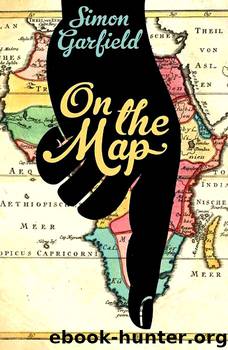On The Map by Simon Garfield

Author:Simon Garfield
Language: eng
Format: epub, mobi
ISBN: 9789085241522
Publisher: For the Benefit of Mr. Kite
Published: 2011-12-31T16:00:00+00:00
Irresistible – Robert Louis Stevenson’s Treasure Island.
Osbourne also remembers Stevenson writing the words ‘Treasure Island’ in the map’s top right-hand corner. ‘And he seemed to know so much about it too – the pirates, the buried treasure, the man who had been marooned on the island.’ In what he recalls as ‘a heaven of enchantment,’ Osbourne then exclaimed ‘Oh, for a story about it!’
Whether the story was already underway, or whether this map was the inspiration for the thirty-one-year-old Stevenson’s first complete book (and who wouldn’t claim to be the spark for one of the classics of world literature?), remains the subject of conjecture. Looking back at his creation for an article in The Idler magazine years later, Stevenson wrote of the enthusiasm of his stepson for the early drafts of his work as it appeared in early serialised form in Young Folks magazine, but he claimed the map as his own work. ‘I made the map of an island. It was (I thought) beautifully coloured; the shape of it took my fancy beyond expression; it contained harbours that pleased me like sonnets…’ He also claimed it drove the plot: once he had constructed a place called Skeleton Hill, ‘not knowing what I meant’, and placed it at the south-east corner, he then directed the narrative around it.
Stevenson had created a moral fable of venality, vice and some virtue. Treasure Island is a coming-of-age story, and its obsession with disease and disability mirrors Stevenson’s own battle with illness from childhood. Its swashbuckling narrative is also a rebellion against the high-Scottish moralising that almost suffocated its author in his youth. The book defined our communal mental vision of piracy, parrots, peg-legs, rum rations, and mutiny with Bristolian accents, and the treasure map within it not only drives the plot but stealthily does something else: it forms the basis of how we imagine treasure maps to this day – ragged, mischievous, curling and foxed, with not quite enough information to make those who hold it sure of their course, yet just enough to fire up a life-defining quest.
In 1894 Stevenson wrote that all authors needed a map: ‘Better if the country be real, and he has walked every foot of it and knows every milestone. But even with imaginary places, he will do well in the beginning to provide a map; as he studies it, relations will appear that he had not thought upon; he will discover obvious, though unsuspected, short cuts and footprints for his messengers; and even when a map is not all the plot, as it was in Treasure Island, it will be found to be a mine of suggestion.’
♦
Maps in our minds are powerful things, and those we see as children may never leave us. We may already know the shape of E.F. Knight’s Trinidad, as it was a model for Arthur Ransome’s fictional Crab Island in Peter Duck, the third of his Swallows and Amazons adventures, published in 1932.
Download
This site does not store any files on its server. We only index and link to content provided by other sites. Please contact the content providers to delete copyright contents if any and email us, we'll remove relevant links or contents immediately.
| Anthropology | Archaeology |
| Philosophy | Politics & Government |
| Social Sciences | Sociology |
| Women's Studies |
Cecilia; Or, Memoirs of an Heiress — Volume 1 by Fanny Burney(31360)
Cecilia; Or, Memoirs of an Heiress — Volume 3 by Fanny Burney(30957)
Cecilia; Or, Memoirs of an Heiress — Volume 2 by Fanny Burney(30913)
The Great Music City by Andrea Baker(21819)
We're Going to Need More Wine by Gabrielle Union(18092)
Bombshells: Glamour Girls of a Lifetime by Sullivan Steve(13125)
Pimp by Iceberg Slim(12957)
All the Missing Girls by Megan Miranda(12791)
Fifty Shades Freed by E L James(12470)
Talking to Strangers by Malcolm Gladwell(11922)
Norse Mythology by Gaiman Neil(11919)
Crazy Rich Asians by Kevin Kwan(8381)
Mindhunter: Inside the FBI's Elite Serial Crime Unit by John E. Douglas & Mark Olshaker(7860)
The Lost Art of Listening by Michael P. Nichols(6494)
Enlightenment Now: The Case for Reason, Science, Humanism, and Progress by Steven Pinker(6422)
Bad Blood by John Carreyrou(5790)
The Four Agreements by Don Miguel Ruiz(5539)
Weapons of Math Destruction by Cathy O'Neil(5061)
We Need to Talk by Celeste Headlee(4890)
